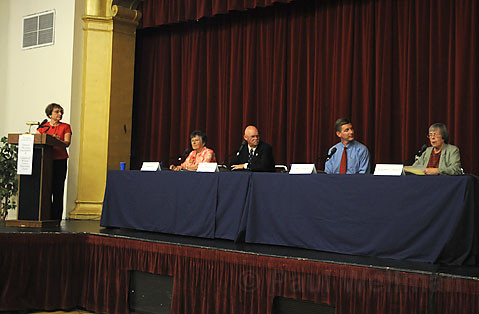A Short History of Goleta’s District Elections
Will the Third Time Be the Charm?

The third time may be the charm for district elections in the City of Goleta. The Notice of Violation of California Voting Rights Act the city received on February 6 asserts that the city defeated district elections in 2001, but Margaret Connell, the city’s first mayor, recalls it differently. City residents narrowly approved by-district elections in the vote for incorporation in 2001, but city divisions were never implemented.
Back in November 2001, voters were asked to choose by-district versus at-large elections as part of the city incorporation vote. County election records show the measure passed in favor of district elections by 50.85 to 49.15 percent, a win by 96 votes among 5,630 cast.
The city attorney at the time, Julie Hayward Biggs, then with Burke, Williams and Sorensen in Riverside, vividly remembered staying in Goleta Monday through Friday for weeks on end, coming from her Riverside office to participate in public meetings. The people were asked to help decide on district boundaries, she said, along with Claremont McKenna’s Rose Institute, a part of the college’s Government Department, and National Demographics Corporation, which drew up the maps.
In the process, Hayward Biggs said, all involved came to realize that for a small city like Goleta, “districts would start to divide the community, just when coming together was the purpose.” It would be easier for politicians to reach their constituents in a smaller portion of the city, she acknowledged, but an orientation toward the city as a whole could be lost. She also said that the city was not under threat of litigation for district elections at the time, but that the city mothers and fathers chose to clarify the choices with ballot measures.
Jean Blois, who served on Goleta’s first City Council and also as mayor, recalled no agreement formed on a district map in the public meetings, and no agreement on the best method of choosing the council, either. They felt it was a matter for the citizens to decide again.
The next election, the March 2004 primaries, offered an at-large city council slate and three district measures. Voters were asked to choose between “by district,” “from district,” or “at large.” “By” and “from” lost by 61.62 and 59.39 percent, respectively, while “at large” won by 57.03 percent. The city has held at-large elections ever since, though that is likely to change.
The letter received February 6 gives the council 45 days to “adopt a resolution outlining its intention to transition from at-large to district elections.” The demand was signed by two Old Town residents, Lindsey Rojas and Hector Mendez, acting for the District Elections Committee, organized for the same fight in the City of Santa Barbara. The current City Council takes the matter up on March 7, said city spokesperson Valerie Kushnerov.
The staff report for that meeting says the law gives the council 30 days to hold public hearings on district composition, and another 45 days after maps are drawn for additional public input. The city’s eligible voters are 29 percent Latino, largely found in Old Town and central-western Goleta. The agenda and staff report for the March 7 meeting, which starts at 6 p.m., is available here.
Margaret Connell, who is a frequent contributor to The Independent, wondered whether district elections would be effective. She observed that the afternoon council meetings held twice a month could be a burden to anyone who works, as would the numerous committee meetings. “If the issue is getting people to run, making accommodations with the council schedule might have better results in terms of representation.”


